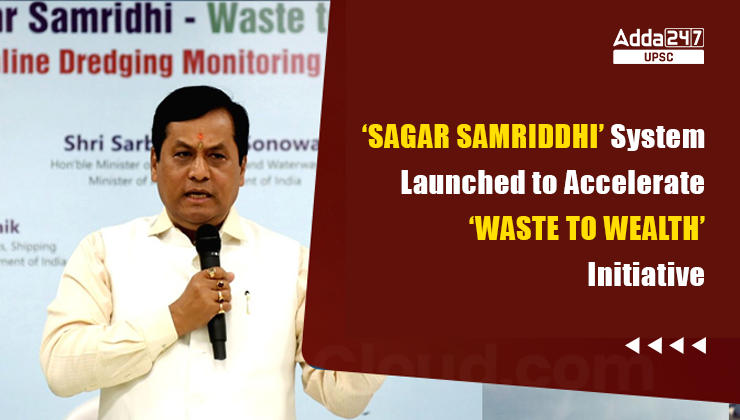Table of Contents
‘SAGAR SAMRIDDHI’: The ‘SAGAR SAMRIDDHI’ monitoring system offers several key capabilities, including real-time dredging progress reports, daily and monthly progress visualization, dredger performance and downtime monitoring, and easy location tracking with snapshots of loading, unloading, and idle time. ‘SAGAR SAMRIDDHI’ System is also important for UPSC Prelims Exam and UPSC Mains Exam (GS Paper 3- Environment and Ecology).
‘SAGAR SAMRIDDHI’ in News
The Minister of Ports, Shipping & Waterways (MoPSW) and Ayush, Shri Sarbananda Sonowal, unveiled ‘SAGAR SAMRIDDHI’ to expedite the Ministry’s ‘Waste to Wealth’ initiative. The program was attended by the Secretary of MoPSW, Sudhansh Pant, as well as other senior officials from the Ministry, Major Ports, and Organizations.
‘SAGAR SAMRIDDHI’ System Details
The Ministry has developed the online dredging monitoring system called ‘SAGAR SAMRIDDHI’ to expedite the ‘Waste to Wealth’ initiative.
- Capabilities: Capabilities of ‘Sagar Samriddhi’ include:
- Real time dredging progress report
- Daily and monthly progress Visualisation
- Dredger performance and downtime monitoring
- Easy location track data with snapshot of loading, unloading and idle time
- Developing Institution: The National Technology Centre for Ports, Waterways, and Coasts (NTCPWC), the technological branch of MoPSW, has developed this system.
- Significance: The ‘SAGAR SAMRIDDHI’ monitoring system is expected to enable better productivity, better contract management and also effective reuse of dredged material with waste to wealth concept.
‘SAGAR SAMRIDDHI’ System Implementation
SAGAR SAMRIDDHI’ System offers significant improvements over the old Draft & Loading Monitor (DLM) system.
- The new technology enhances coordination among various input reports such as daily dredging reports and pre/post-dredging survey data.
- It enables real-time dredging reports and facilitates features like daily and monthly progress visualization, dredger performance and downtime monitoring, and easy location tracking with snapshots of loading, unloading, and idle time.
- The implementation of the ‘Sagar Samriddhi’ monitoring system aligns with the vision of Atmanirbhar Bharat (self-reliant India) and the Make in India initiative.
National Technology Centre for Ports, Waterways, and Coasts (NTCPWC)
The National Technology Centre for Ports, Waterways, and Coasts (NTCPWC) was established under the Sagarmala Programme of MoPSW with the total investment of ₹ 77 Crores at IIT Madras.
- The primary objective of this center is to facilitate research and development activities for the marine sector, aiming to strengthen and enhance the country’s marine industry.
- Equipped with cutting-edge technology and facilities, the NTCPWC is capable of conducting comprehensive 2D and 3D investigations, research, and consultancy work across various disciplines related to the Port, Coastal, and Waterways sector.
- Its capabilities include-
- Ocean modeling,
- Analysis of coastal and estuarine flows,
- Sediment transport and morph dynamics,
- Navigation and maneuvering planning,
- Dredging and siltation estimation,
- Consultancy in port and coastal engineering,
- Design of structures and breakwaters,
- Autonomous platforms and vehicles,
- Experimental and computational fluid dynamics modeling of flow and hull interaction,
- Hydrodynamics of multiple hulls, and
- Ocean renewable energy coupled with port facilities.
- The laboratories established at NTCPWC are considered among the finest in the specific domain, comparable to international standards.
Waste to Wealth Mission
The Waste to Wealth Mission is being led by the Office of Principal Scientific Advisor to the Government of India (O/o PSA). The objective of Waste to Wealth Mission is to enhance the waste management system in the country by showcasing inventive solutions and models to attain a zero landfill and zero waste nation. The mission aims to reinforce the Swachh Bharat Mission and Smart Cities Project by using science, technology, and innovation.
Waste to Wealth Initiative Aspects in India
Here are some key aspects of the Waste to Wealth initiative in India:
- Swachh Bharat Abhiyan (Clean India Mission): Launched in 2014, this nationwide campaign focuses on improving cleanliness and sanitation across the country. It aims to achieve 100% open defecation-free status, solid waste management, and effective waste segregation.
- Waste Segregation: Proper waste segregation at the source is crucial for effective waste management. Many cities and municipalities in India have implemented waste segregation programs where households are encouraged to separate waste into different categories such as organic waste, recyclables, and non-recyclables.
- Composting: Organic waste constitutes a significant portion of the waste generated in India. Composting is an effective method to convert organic waste into nutrient-rich compost that can be used as fertilizer for agriculture and gardening. Many cities have set up decentralized composting units and community composting programs.
- Waste-to-Energy Projects: To tackle the problem of non-recyclable waste, several waste-to-energy projects have been implemented in India. These projects involve the conversion of non-recyclable waste into energy in the form of electricity or heat through processes such as incineration, gasification, or anaerobic digestion.
- Plastic Waste Management: India has been actively working towards reducing plastic waste through various initiatives. These include the implementation of a ban on single-use plastic in many states and the promotion of alternatives like biodegradable packaging materials. Plastic recycling and upcycling projects are also being encouraged.
- E-waste Management: With the rapid growth of the electronic industry, e-waste has become a significant concern. The government has introduced regulations and guidelines for the proper disposal and recycling of electronic waste. E-waste recycling facilities are being set up to recover valuable metals and reduce the environmental impact of electronic waste.
- Waste Management Startups: The Waste to Wealth initiative has also spurred the growth of waste management startups in India. These startups focus on innovative solutions for waste collection, recycling, upcycling, and creating value from waste materials.
India’s solar PV Waste Problem, Challenges and Way Forward
| Follow US |
| UPSC Govt Jobs UPSC Current Affairs UPSC Judiciary PCS Download Adda 247 App here to get the latest updates |



 TSPSC Group 1 Question Paper 2024, Downl...
TSPSC Group 1 Question Paper 2024, Downl...
 TSPSC Group 1 Answer key 2024 Out, Downl...
TSPSC Group 1 Answer key 2024 Out, Downl...
 UPSC Prelims 2024 Question Paper, Downlo...
UPSC Prelims 2024 Question Paper, Downlo...
